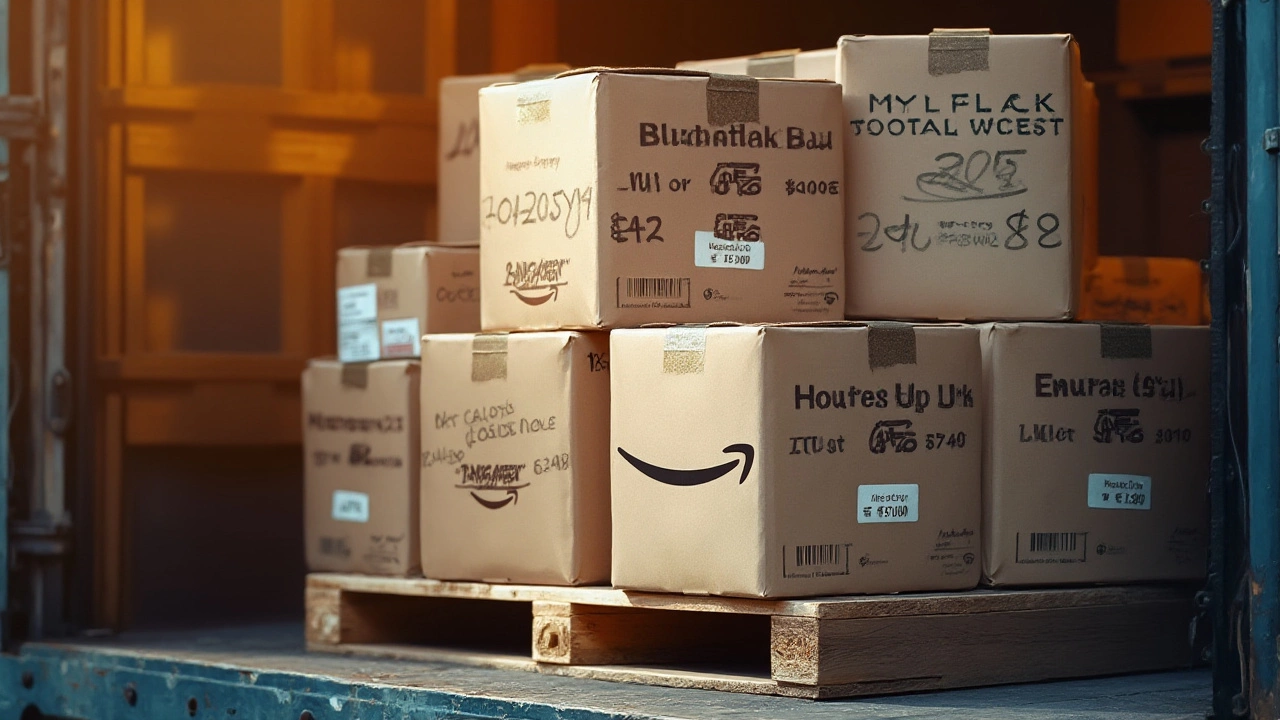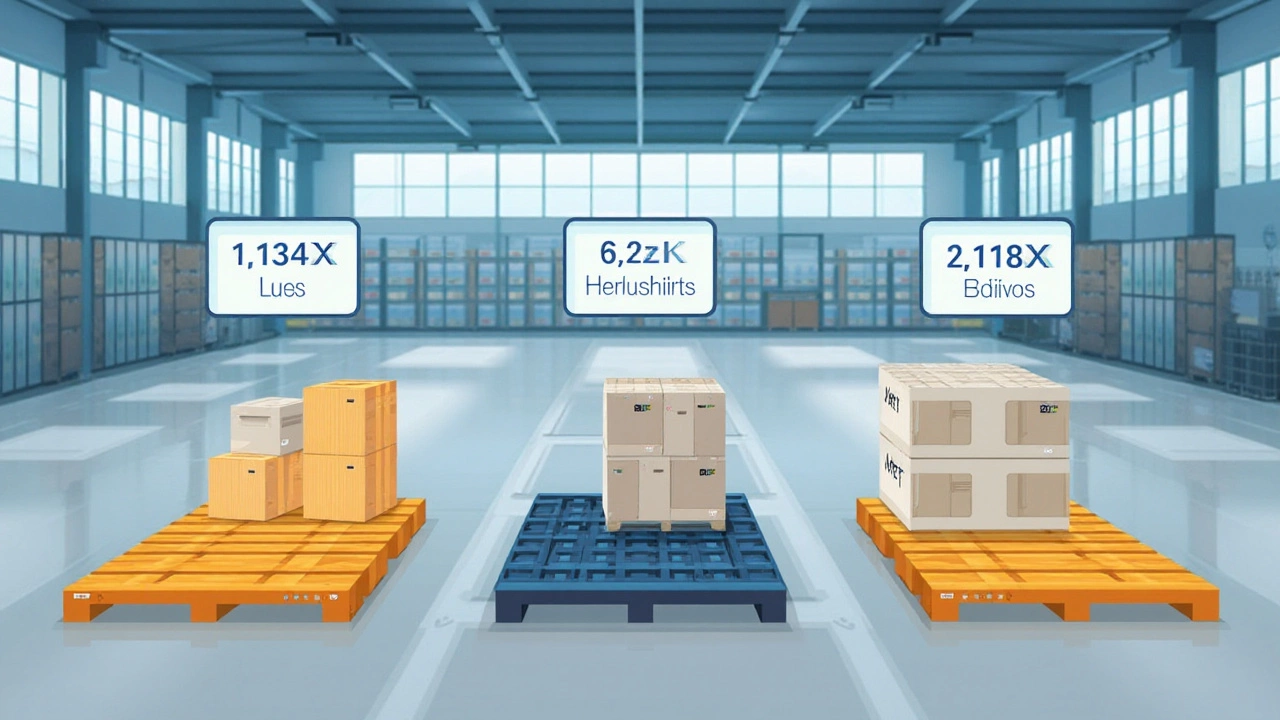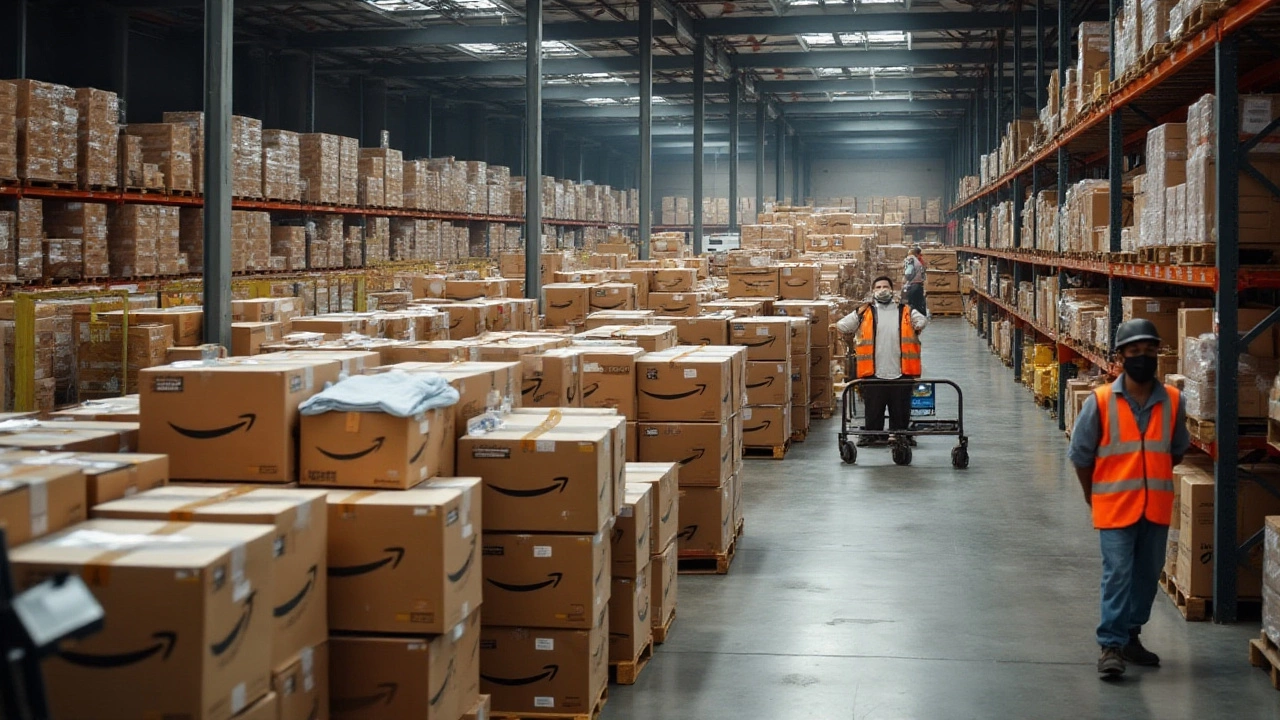In today's bustling e-commerce market, Amazon pallets serve as the silent workhorses that keep the wheels of commerce turning smoothly. Though they may not always enter the limelight, these pallets play a crucial role in the world of logistics. Understanding their value isn't just about dollars and cents, but involves a myriad of factors that determine their price and efficiency.
Whether you're a seasoned logistics pro or someone just curious about how your favorite products make it to your doorstep, understanding the ins and outs of Amazon pallets is both intriguing and useful. From what's loaded onto them, to how they're priced and delivered, this piece aims to shed light on the various facets of the pallet delivery process.
By breaking down the core aspects of what goes into the cost of an Amazon pallet, and exploring the logistics behind the scenes, we endeavor to provide a clear and comprehensive picture of the entire process. Through simple insights and practical tips, we hope this guide will become your go-to resource for all things related to pallet delivery.
- Defining an Amazon Pallet
- Factors Influencing Pallet Prices
- Types of Goods Shipped on Amazon Pallets
- Understanding Shipping Costs
- Tips for Efficient Pallet Delivery
- Future Trends in Pallet Logistics
Defining an Amazon Pallet
An Amazon pallet is a standardized wooden or composite structure that serves as a stable base for storing and transporting goods. These pallets are engineered to maximize efficiency and safety during the shipping process, making them indispensable in the world of ecommerce logistics. Effective pallet utilization helps streamline operations by allowing forklifts and pallet jacks to move items quickly and securely, reducing the risk of damage during transit. Understanding the core characteristics of an Amazon pallet requires a closer examination of its dimensions, weight capacity, and material composition. While the standard size is typically around 48x40 inches, these pallets can be customized to suit specific needs, accommodating a wide range of product dimensions and weights. This variability makes them versatile components in the supply chain. Interestingly, the implementation of pallets dates back to World War II, when more efficient freight loading methods were in high demand. These innovations have since evolved into the sophisticated system that powers modern commerce today.
Each Amazon pallet is packed with merchandise from various categories, such as electronics or household goods, aligned with the online retailer's diverse inventory. The pallet's structural design is crucial in supporting substantial weight, often holding up to 4,600 pounds. The material choice—whether wood, plastic, or metal—affects its durability and environmental impact, with wood being the most common due to cost-effectiveness and recyclability. Safety is a top priority in pallet design, ensuring secure stacking and minimizing potential hazards. As a grand choreographer orchestrating a dance of goods, the Amazon pallet is an integral performer in the elaborate ballet of global trade. As reported by the National Wooden Pallet & Container Association, nearly 90% of all goods move on a pallet at some point, showcasing their ubiquity and importance. A fascinating fact is that an estimated two billion pallets are in use across the United States alone. This statistic underscores the critical role they play in logistics worldwide.
Moreover, customizing an Amazon pallet for specific products can significantly enhance distribution efficiency. These pallets may incorporate unique features such as corner protectors or anti-slip coatings to address particular shipping needs. A tailored pallet solution optimizes load capacity, often introducing innovations that decrease excess packaging and support sustainability efforts. The concept is much like fitting a tailored suit—subtly modifying dimensions and materials maximizes performance while catering to unique demands. Sometimes, pallets undergo treatments to comply with international standards, ensuring plant health safety alongside logistical practicality. For instance, heat treatment or fumigation might be required before overseas shipping to prevent pest infestations. One might say pallets are akin to unsung heroes in the logistics industry, shouldering hefty loads and silently enabling the seamless flow of commerce in a world increasingly dependent on prompt delivery.
"Pallets are not just wooden platforms; they are a fundamental part of the supply chain ecosystem," says Dirk Becker, logistics expert and industry consultant.
Factors Influencing Pallet Prices
The price of an Amazon pallet is determined by an intricate web of factors far beyond the surface level costs of materials and construction. The journey from manufacturer to consumer is paved with considerations that each add their own layers to the final pricing puzzle. Among these, perhaps the most significant is the type and quantity of goods the pallet will carry. Every inch of space on a pallet can be meticulously calculated to maximize efficiency while minimizing empty space. This requires a delicate balance; more weight or size might mean fewer pallets per shipment, thus scaling up costs. Moreover, the nature of goods—whether they are fragile electronics or durable canned goods—can influence protective packaging and handling fees, subsequently affecting the price.
Another pivotal aspect is the distance that the pallet needs to travel, which directly impacts transportation costs. Shipping a pallet overseas differs drastically in cost compared to trucking it a few states over. The method of transit, too—whether by sea, air, rail, or road—affects not only price but also speed, reliability, and potential environmental impact. Intriguingly, global oil prices can cause fluctuations in transport expenses, making timing an unpredictable yet vital element.
Logistics also plays a crucial yet sometimes undervalued role in pricing pallets. Warehousing costs, including storage duration and conditions, can stack up surprisingly fast. Facilities need to be outfitted with specialized equipment for loading and unloading, which translates to additional labor costs. Over time, warehousing innovations like automated retrieval systems can also influence overall price through initial investments and long-term savings.
A lesser-known but impactful component of pallet pricing is regulatory compliance. Different regions have varying standards for the treatment of shipping containers, particularly when it comes to international borders. For instance, some countries require heat-treated or fumigated pallets to prevent pest transfer, according to the International Plant Protection Convention stipulations. Such requirements add a necessary but sometimes costly layer to the equation. As noted by logistics expert James Morefield, "The cost of compliance often escapes notice until it hits the invoice, but it remains an essential part of global trade."
The complexities of seasonal demands also cannot be understated. During peak shopping periods like the holiday season or Black Friday, demand for shipping and logistics services skyrockets, driving prices upwards through the fundamental economic principles of supply and demand. Companies often negotiate shipping contracts well in advance to mitigate sudden price hikes during these high-demand periods.
Lastly, the rise of technology and innovation is reshaping how costs are assessed and managed. Advances in tracking and automation can streamline entire logistics chains, potentially leading to cost reductions. At times, even seemingly small shifts like switching to digital tracking systems can lead to significant price adjustments in logistics and supply chain management. Embracing these changes, companies are finding new ways to refine and revolutionize their operations, promising a future where the factors influencing pallet prices may evolve in unexpected and fascinating ways.

Types of Goods Shipped on Amazon Pallets
Amazon pallets are diverse in nature, accommodating a wide array of goods that span multiple categories. At their core, these pallets are designed to move products efficiently from warehouses to shipping centers and, ultimately, to the customer. A glance at what’s typically found on Amazon pallets reveals a fascinating cross-section of consumerism, from everyday essentials to the latest electronic gadgets. The variety of items is a reflection of Amazon’s vast inventory, featuring everything from household cleaning supplies and pantry staples to the newest smart TVs and laptops. It’s a logistical ballet where bulk goods like pet food and bottled water might share space with office supplies and even seasonal merchandise such as holiday decorations.
The versatility required to orchestrate this logistical feat cannot be overstated. The pallets used must be sturdy enough to handle an assortment of weights and sizes. Countless small businesses depend on these pallets to efficiently manage their inventory, sending everything from hand-crafted goods to factory-produced items. This diversity presents an interesting challenge but also demonstrates the adaptive nature of modern shipping and handling. The ability to fulfill such varied product needs is a testament to Amazon's sophisticated supply chain strategies.
To handle such wide-ranging assortment, the packing strategy is paramount. This strategy ensures not only that the most durable items face minimal risk but also that the more delicate and higher-value goods receive special attention during transit. For instance, products like electronics, which include noise-canceling headphones and digital cameras, are often packaged with protective padding and secured with tight packing arrangements. This ensures that no harm comes to these goods, which can endure jostling during transportation. Speaking of electronics, there was a report by MarketWatch noting that consumer electronics shipments account for approximately 15-20% of all freight, hinting at their significant presence on these pallets.
Moreover, the seasonality of products can influence what gets shipped on these ordelies. During holiday seasons, for instance, pallets can see an influx of toys and festive decorations, whereas during back-to-school season, there might be a surge in books, stationery, and electronics geared towards students. This fluctuation can affect not only the contents of the pallets but also their overall weight and fragility. Understanding these patterns helps businesses better prepare their logistical strategies and anticipate potential challenges that come with the ebb and flow of demand.
A strategic blend of analytics and practical foresight allows Amazon to dynamically manage what goods are loaded onto each pallet. The ultimate goal is to masterfully use space and minimize costs – a balance that's key to maintaining their competitive edge in the market. By ensuring each pallet is packed to its optimal capacity, more goods can be moved simultaneously, resulting in fewer shipments. This means not only lower costs for the company but also a reduced environmental impact, a factor that’s becoming increasingly important in logistics circles as companies strive to implement more eco-friendly solutions.
Understanding Shipping Costs
Shipping costs, particularly in the realm of pallet delivery, encompass a variety of factors that contribute to the total price. One of the first things to consider is the weight and dimensions of an Amazon pallet. Typically, larger and heavier pallets incur higher costs, mainly due to the fuel charges and handling fees involved. Delivery distance also plays a critical role. Shipping a pallet across vast distances, say from coast to coast in the United States, requires more energy, time, and resources, leading to increased costs. Moreover, the mode of transportation—be it by air, sea, or road—significantly affects the price, with air freight generally being the most expensive choice due to its speed and convenience.
Another crucial aspect is the type of goods being shipped on the Amazon pallet. Certain items, such as perishables or fragile goods, may demand special handling or climate-controlled containers, which naturally raises the shipping fee. Insurance is another component frequently factored into shipping costs, providing a safety net for both shippers and receivers against potential damage or loss. Various carriers may have different policies, impacting the final pricing.
Market Trends and Their Effects
Today’s shipping market doesn't operate in isolation, and recent trends have a notable impact on pricing. The rise of fuel prices is a prime example, directly influencing the baseline cost of transporting goods. Economic factors, such as inflation or supply chain disruptions, also cause fluctuations in shipping prices. According to the International Transport Forum, global freight costs surged by approximately 30% over the past year due to these economic variables.
“The shipping industry is facing pressure from all sides—from escalating fuel costs to labor shortages, each factor adding layers of complexity to pricing models.”To cope with this, businesses often need to employ strategic planning and leverage technology for a more streamlined logistics process.
Customer expectations around delivery times can add another layer of complexity to shipping costs. With the burgeoning demand for quicker deliveries, expedited shipping is often on the table. While this meets the rapid-pace demands of digital consumers, it does come at a premium. Notably, giant e-commerce platforms like Amazon might encourage increased shipping speed, which may entail higher costs for businesses that do not meet specific thresholds. As part of managing these expenses, businesses frequently engage in negotiations with shipping companies for discounted rates, especially when dealing with bulk shipments. Understanding these dynamics is essential, providing businesses with the ability to critically assess their shipping strategies and potentially work towards minimizing costs wherever feasible.

Tips for Efficient Pallet Delivery
Ensuring efficient pallet delivery is like being the conductor of a symphony, where each component plays a crucial role in perfect harmony. To orchestrate a seamless delivery, one must start by selecting the right type of pallet. The choice between wood, plastic, or metal isn't just aesthetic; it's a decision influenced by the nature of the goods, weight, and even the climatic conditions of the delivery route. Wood pallets are generally sturdy and economical, but they might not suit products sensitive to contaminants or moisture. On the other hand, plastic pallets, while slightly more expensive, offer durability and a cleaner surface but may not support extremely heavy loads. The cost-conscious yet quality-driven choices you make at this stage lay the groundwork for a smooth fulfillment process.
Once the pallets are selected, attention shifts to the pivotal task of organizing the goods. It's a good practice to ensure that the heaviest items are placed at the bottom, creating a stable base. Each layer should be meticulously balanced to prevent any tilting or toppling during transit. Utilizing protective materials such as bubble wrap or foam padding can prevent any scratches or dents in transit. Another key consideration is the strategic placement of labels and documentation, making it accessible and visible for handlers. This not only speeds up inspection processes but also minimizes the risk of misplacements. Efficient organization is akin to laying a strong foundation, enabling shipments to reach destinations intact and without delay.
Incorporate Technology and Training
In today's technology-driven world, incorporating technology in logistics is no longer optional but necessary. From RFID tags that track shipments with precision to automated software systems that streamline routing, technology plays a transformative role. According to a study by the Logistics Bureau, businesses that leverage technology in their supply chain witness a 30% boost in operational efficiency. These tech tools provide real-time updates, offering transparency and reducing uncertainties. Parallelly, investing in training your workforce cannot be underestimated. A well-trained team can spot inefficiencies and implement corrective measures, ensuring that the shipping costs remain within budget. As the age-old saying in logistics goes, a knowledgeable worker is an asset who enhances every aspect of delivery operations.
Taking advantage of analytics and data insights can further refine the delivery process. By reviewing historical data on delivery times, obstacles encountered, and feedback from logistics partners, companies can adjust their strategies proactively. A quote from Alex Martin, Delco Freight's CEO, encapsulates this approach:
“Embracing data-driven decisions not only enhances accuracy but also allows room for innovation and improvement.”Efficient delivery isn't merely about speed but also consistency and reliability, with a data-backed approach serving as the backbone.
| Type of Pallet | Pros | Cons |
|---|---|---|
| Wood | Cost-effective, strong | Susceptible to moisture |
| Plastic | Durable, clean | More expensive |
| Metal | Extremely durable | Heavy, costly |
Taking a pragmatic approach to Amazon pallet delivery can set your logistical efforts on the right course. From choosing the appropriate type of pallet to integrating technology, training, and data insights, every action contributes to a concerted, effective delivery process. These methods not only optimize costs but also ensure that each delivery unfolds with precision, embodying the essence of a well-oiled machine that operates efficiently across the dynamic landscape of ecommerce logistics. Prioritizing these facets can create a streamlined and effective logistical system resonant with success and customer satisfaction.
Future Trends in Pallet Logistics
As we march onward into a future dominated by rapid technological advancements, the realm of pallet delivery is set to transform in fascinating ways. One of the most significant trends we're seeing is the integration of autonomous technology, which promises to revolutionize how pallets are transported and managed. Companies are investing heavily in robotics, not just for warehouse automation, but also in autonomous vehicles that can streamline the entire logistics chain from the factory to the doorstep. Imagine a world where your Amazon pallet is loaded onto a driverless truck, optimizing routes in real time to save fuel and time.
Another trend gaining traction is the use of smart technology. RFID tags and IoT devices are being employed to enhance the traceability and security of shipments. This technology allows for real-time tracking, providing companies and customers with precise data about the whereabouts of their products. It also helps in reducing human error and increasing efficiency, allowing logistics firms to make data-driven decisions that can cut costs and improve service quality. As these technologies become more affordable, their adoption is likely to become ubiquitous.
Sustainability is also becoming a key focus for companies involved in pallet delivery. With the increasing pressure to reduce carbon footprints, firms are turning towards eco-friendly materials and practices. Recyclable and biodegradable pallets are being developed to replace traditional wood and plastic varieties. Additionally, many companies are optimizing their supply chains to minimize waste and promote green logistics. According to the International Transport Forum, logistics operations account for a substantial percentage of carbon emissions worldwide, highlighting the importance of these initiatives.
Blockchain technology is emerging as a powerful tool for transparency and trust in logistics operations. By using a decentralized ledger, companies can ensure that every transaction is recorded and verifiable, reducing the risk of fraud and error. This system allows stakeholders to have a shared, immutable record of all transactions, enhancing transparency throughout the logistics process. It also holds the promise of simplifying customs processes, potentially speeding up international deliveries and reducing paperwork.
In the realm of global commerce, changing customer expectations are driving innovation. Today's consumers expect faster deliveries with more flexible options, propelling logistics firms to adopt technology that can meet these demands. Same-day and next-day delivery services are no longer luxuries but standard offerings. As such, companies are looking to enhance their logistical capabilities to stay competitive. To achieve this, many are investing in sophisticated algorithms and predictive analytics to anticipate demand and streamline operations.
"The logistics industry is entering a new era of digitization and automation," stated Sarah Barnes-Humphrey, a recognized expert in supply chain innovation. "Companies that can adapt to new consumer demands with speed and innovation will be those that lead the future."
Finally, the future landscape of pallet logistics is closely tied to geopolitical and economic shifts. Trade agreements, tariffs, and regulations continue to reshape the global supply chain. Logistics companies must stay informed and agile to navigate these challenges effectively. Investing in flexible infrastructure and forging strategic partnerships allows firms to mitigate risks and capitalize on emerging opportunities.


